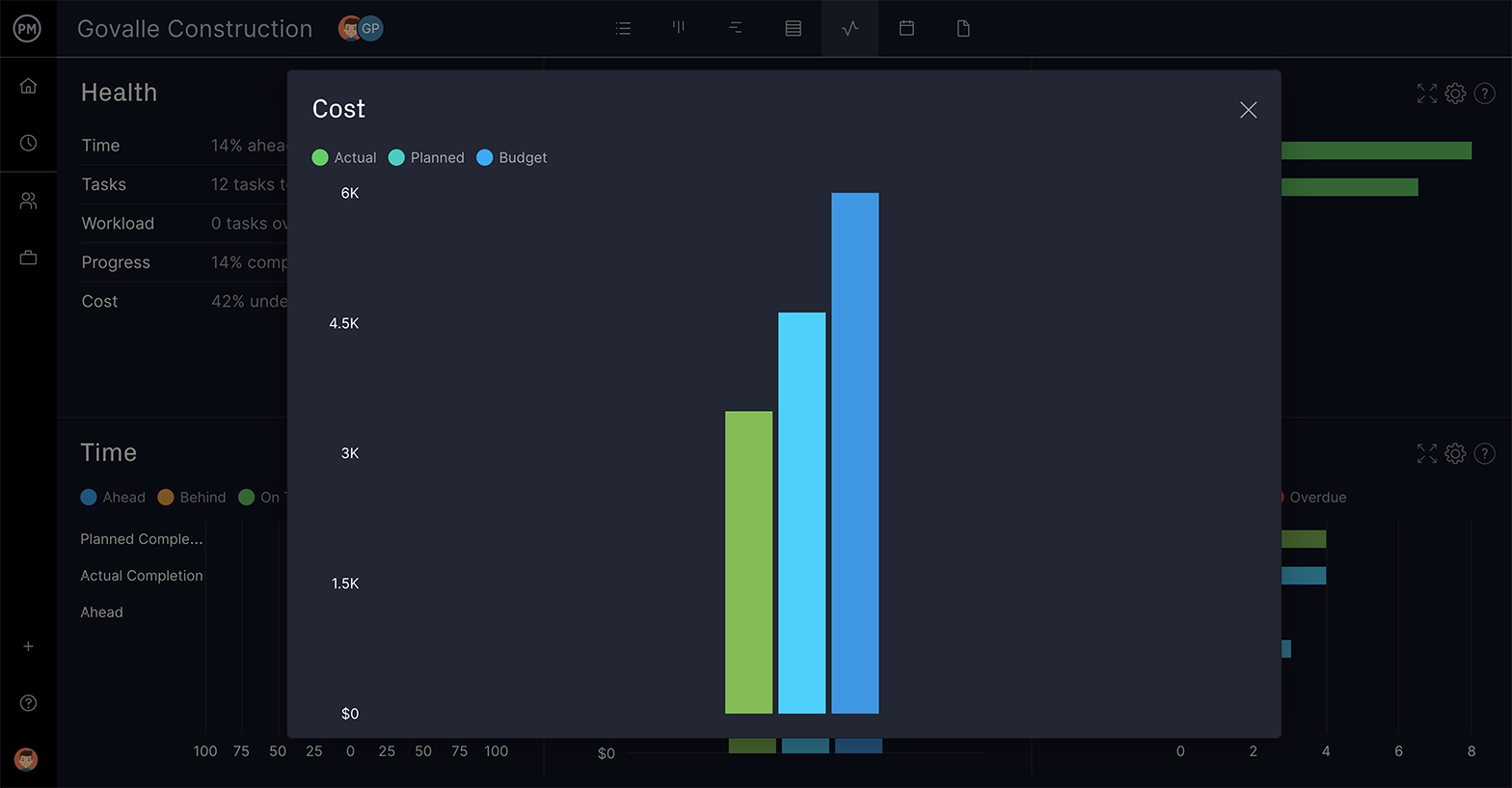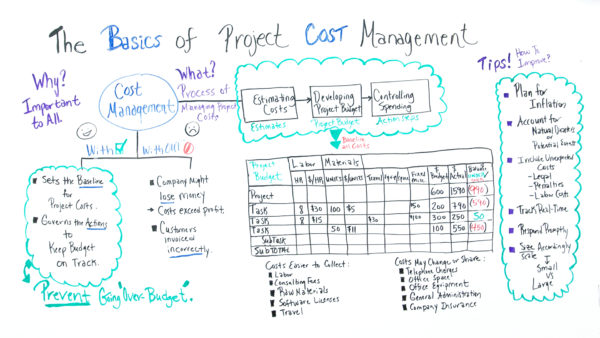[ad_1]
What Is Cost Management?
Cost management is the process by which one plans and manages the budget of a business or project. In the case of a project, it helps the project manager estimate what the project will cost and set in place controls by which they can reduce the chance of the project going over budget.
Cost management is one of the most important responsibilities of a project manager because projects always need resources such as materials, labor and equipment, which generate costs. Those costs must be estimated and controlled throughout the project life cycle so that the project can be completed.
Effective cost management requires the right software. ProjectManager is the perfect tool to track project costs, resources and workload. Our Gantt charts, project calendars and timesheets allow you to manage costs, time and tasks. Get started for free.

How to Manage Project Costs in 4 Steps
The four steps below will allow you to understand how the cost management process works in project management.
1. Resource Planning
Resource planning is the process of forecasting future resource requirements for a business, project or a scope of work. To create a resource plan, you need to start by defining the project scope, a document that details the project activities that will be done.
Once all the project activities have been defined, project managers usually rely on historical data, expert’s opinions, and resource planning tools such as a resource breakdown structure (RBS) to estimate the resources that will be needed.
2. Cost Estimating
Cost estimating consists in assigning costs to the resources you need to execute your project, such as labor, materials and equipment. Cost estimating is one of the most important steps in the cost management process because it lays out the base for your project budget. There are several cost estimating techniques you can use depending on the characteristics of your project.
3. Cost Budgeting
Based on your cost estimates, you can now create a project budget, which is simply the sum of all your project costs. Make sure to include all types of project costs, including direct, indirect, fixed and variable costs. A project budget should also include contingency reserves in case there’s rework that needs to be done, or a risk has struck the project and risk mitigation strategies need to be taken.
Once the project starts, the project budget is a baseline that’s used to compare actual costs vs estimated costs. Therefore, project budgets allow project managers to quickly understand if their costs are too high and there’s risk of cost overrun.
4. Cost Control
Cost control refers to all the activities, guidelines and procedures that are taken to minimize and track project costs. Poor cost control can affect the profitability of a project, but luckily project management software can help you to easily keep track of costs with tools such as timesheets, workload planners and project dashboards.
The outputs of these 4 steps can be documented in a cost management plan, a critical component of the project plan.
What Is a Cost Management Plan?
A cost management plan sounds simple. It’s an outline of the cost estimation for the project—but that includes all allocation and how the project manager will control those costs to bring the project in as budgeted.
A cost management plan must take into account the resources that impact the project budget, whether materials or people. There are also fixed, variable and overhead costs. All these must be calculated to know what your financial commitment to the project will be.
Last but not least is the stakeholder, who has a vested interest in keeping costs down. Cost overrun is a problem many projects experience, but not one that stakeholders are going to be very tolerant of. Keep the stakeholder in mind when formulating your cost management plan. They need to stay in the loop and get reports throughout the project.
Cost Management Plan Outline
Here are some of the key elements that must be included in the cost management plan:
- Precision and accuracy is important, especially if you’re rounding numbers, which might seem insignificant but can result in a deviation of cost estimates on projects big and small. It is critical that your figures be as precise and accurate as possible.
- You’ll also want to define the units of measurement because size matters and can make a big difference in your cost estimation.
- Know the cost variations and where you have wiggle room and where you don’t—this is called control thresholds.
- Establish how the project performance will be measured in order to see if you’re meeting the goals and expectations of the project.
- You need to have a format to report your findings as you monitor the project’s progress and present this data to your stakeholders.
Why Is Cost Management Important?
The main reason why cost management is so important in project management is because your cost management plan will include all the guidelines and procedures needed to stay on budget, which is critical because otherwise the organization could lose money as costs exceed profits.
The cost management process begins in the planning phase of the project, where costs are estimated and then a project budget is defined. Then, when the project is executed, the expenses are carefully monitored and recorded to make sure that they’re aligned with the budget.
When you have a project budget, it sets a baseline for project costs. That means it governs the decisions and directions you take when managing costs on your project. This helps you keep the project on track without overspending.
Cost Management Tips
The following are some tips to keep in mind as you’re working on managing your project costs.
- Plan for Inflation: Pricing is not set in stone, and any good budget is going to take this into account by allowing for a range of costs.
- Account for Natural Disasters or Potential Events: Expect the unexpected might sound silly, but you must have room in your budget for a weather event, personal issue or some other unknown that will delay the project.
- Other Unexpected Costs: Not all unexpected costs are random. There can be legal issues, penalties associated with the project or unexpected labor costs, all of which you can’t budget for, but can prepare your budget for.
- Track in Real-Time: Having software to monitor the budget as you execute the project is key for managing costs. However, if you’re looking at data that is not current, you won’t be able to act swiftly enough to resolve issues. Therefore, you want to have software with real-time data tracking.
- Respond Promptly: Regardless of how you discover a discrepancy in your project cost, you must act immediately. The longer you wait, the more money is wasted.
- Size Accordingly: Some people think smaller projects don’t need project cost management. But small or large, you’ll want to manage costs.
In order to best manage project costs, you have to know your project inside and out. The best way to do that is at the start of the project by creating a thorough project charter.
ProjectManager Is Your Cost Management Software
ProjectManager is a cloud-based software that has the tools you need for cost management planning across all phases of your project. Because our software is cloud-based, project data is delivered in real time, so you can immediately gauge the accuracy of your cost estimates against the actual expenditure.
Our resource management feature helps you keep your workload balanced, which reigns in costs. We also have easy-to-use timesheets, where team members can submit with one click and project managers can approve with one click. But, our most powerful feature for cost management is our project dashboard, which tracks project costs in real time, so you can keep a close eye on your budget.

Learn More About Managing Project Cost
When you’re working on cost management, you’re establishing policies and procedures to manage and control your project costs. Jennifer Bridges, PMP, speaks to the core knowledge you need to know in order to understand cost management on any project in this short tutorial video.
Here’s a thumbnail for your reference.

Thanks for watching!
Transcription:
Today, we’re talking about the basics of project cost management. Well, there’s so much to say about cost on projects, but today, I wanna focus on three areas.
I wanna talk about why it’s so important. I wanna talk about what it really is, and then I wanna provide some tips that I found helpful for me in managing the cost of my projects.
Well, first of all, let’s talk about why it’s so important.
Well, it’s important because by using cost management on your project, it helps you to set the baseline for your project cost. And then therefore, that governs the actions you take to keep the budget on track.
So ultimately, what we’re doing is, we’re trying to prevent going over budget. But if we don’t use it, here’s some things that could happen. The company might lose money because some of the costs could exceed the project, and also could cause your customers to be invoiced incorrectly.
So, let’s look at what cost management really is. Well, cost management is a process for managing your cost of your project and it includes estimating your cost.
So, all of the cost on your project, so that you get a detailed list of all the estimates at a task level. Then you take that and you develop your project budget.
So, the deliverable is, you have your project budget that you baseline all your cost again at the task level. And you take that, and it’s used to control the spending for your projects. So, you ultimately…you have a set of action steps you take to keep on track.
So, let’s look at a project budget template. So, when we look at this, we look at the project and we have all of the task or even maybe some subtask.
What we look at, we look at the labor, material cost, and all of the cost. So, the labor is measured in how many hours for that task and how much we’re paying per hour. The task may have some kind of material cost, where we measure that in units, and there is a dollar cost per unit.
Then we have other costs, like, maybe your travel cost, maybe any kind of equipment or space, and any other fixed or miscellaneous cost. Then at the task level, you have your budgeted amount, and as you track along the way, you ultimately get to what it actually costs for that task.
So, in the end, every task and even at the full-project level, you look at where you come out. Like, are you under budget? Are you over budget, at the task level and at the project level?
Again, we’re looking to go under budget. So, there are a few things I wanna point out on the template. So, some costs are easier to collect. Some of those look like your labor cost or even your consulting fees, maybe your raw materials, or even software license, and even your travel cost.
And then some of the costs may change, or they may be shared among other projects, or they may even carry over to other projects. And some of those look like, your telephone charges, maybe even your office space or office equipment, maybe your general administration, and your company insurance.
So, let’s look at some tips on how you can improve managing your cost. Well, first of all, you wanna plan for inflation. If you happen to have a project that is short in duration, it may not be as impacted by inflation, but if an unexpected event occurs, it could impact the inflation on your project.
And again, if you have a longer project in duration that spans a couple of years, inflation may impact it. It may even make your cost increase or it may cause them to decrease.
You also want to account for natural disasters. And we’ve all probably been impacted, or we know people who’ve been impacted, by these natural disasters that can cause your cost, or even may impact some of the resources on your project.
So, you also wanna account for any other potential events. For instance, some industries are impacted maybe by union labor, or any kind of strikes, or things that go on.
So, you also wanna include unexpected cost, and some of those may look like some legal fees maybe you didn’t anticipate, or any kind of penalties maybe in certain industries. They sometimes get penalties and even labor cost. For instance, if for any reason, you need a subject matter expert, those costs may be more than you anticipated.
You also wanna track these in real time so you can respond promptly. Because what we know is, if any deviations happen, they tend to compound and impact your project negatively. So, you also wanna size and scale accordingly.
So some people think, maybe they’re small projects, they don’t really have to do cost management. But any kind of deviations can really impact their budget negatively.
And then large projects, what you wanna do is, you wanna do your cost management and typically at a greater level of detail. But both of these, small versus large, is typically the same process.
But if you need a tool that can help you manage your cost on your project, then sign up for our software now at ProjectManager.
[ad_2]
Source link








